Science Art Found
By Anna Lena Phillips
The Art of Science show turns up turbulence, silicon, squid and more
The Art of Science show turns up turbulence, silicon, squid and more

DOI: 10.1511/2009.79.292
After a two-year hiatus, Princeton University’s Art of Science competition is back—and looking good. Andrew Zwicker, of the Princeton Plasma Physics Laboratory, is one of the show’s organizers and a past prizewinner. The experience of winning and talking with one of the judges, he says, “completely changed how I view my own scientific research and how I look at scientific work in general. I find that I now constantly look for the ‘beauty’ in a scientific result along with its scientific importance.” The more than 200 entrants in the competition did the same; 48 pieces were selected for the show.
Two of these are shown below: “Laser Light through the Eyes of Heat,” by Fatima Toor, and “SU8 flower,” by Guoguang Fu. The full gallery, including details on the science behind each piece, can be viewed online (http://www.princeton.edu/artofscience/2009/).

Art of Science/Princeton University
Until July 1 at noon, visitors to the site can also help select a People’s Choice winner. Matthew J. Salganik, a professor in the Princeton Sociology department, led the development of the voting system. “It is hard for visitors to answer ‘Is this image Art of Science?’ or ‘How much is this image Art of Science?’,” he notes, “but it is possible to answer ‘Which image is more Art of Science?’” Two randomly chosen images from the show are displayed side by side below this question. After each vote, the site generates a new pair.
A 2010 exhibit is in the works, and Zwicker encourages other communities to hold similar competitions. Such efforts may help facilitate a two-way flow of interdisciplinary collaboration. “While artists are often inspired by science,” Zwicker says, “there is a tremendous amount of untapped inspiration that scientists could find by working closely with artists.”
Click "American Scientist" to access home page
American Scientist Comments and Discussion
To discuss our articles or comment on them, please share them and tag American Scientist on social media platforms. Here are links to our profiles on Twitter, Facebook, and LinkedIn.
If we re-share your post, we will moderate comments/discussion following our comments policy.